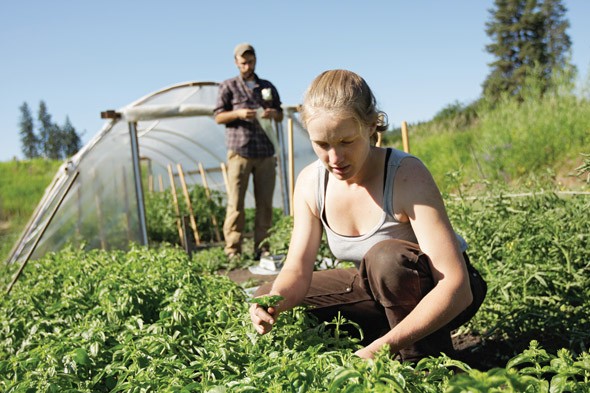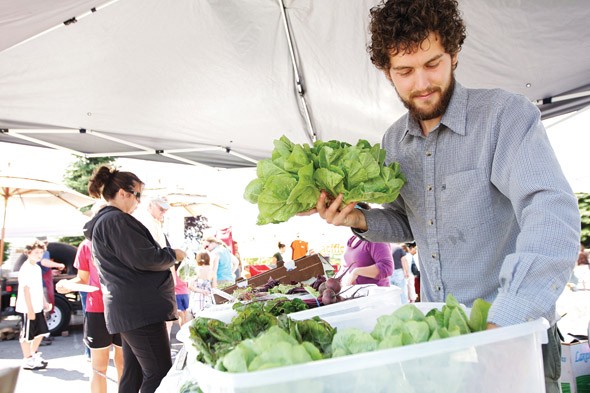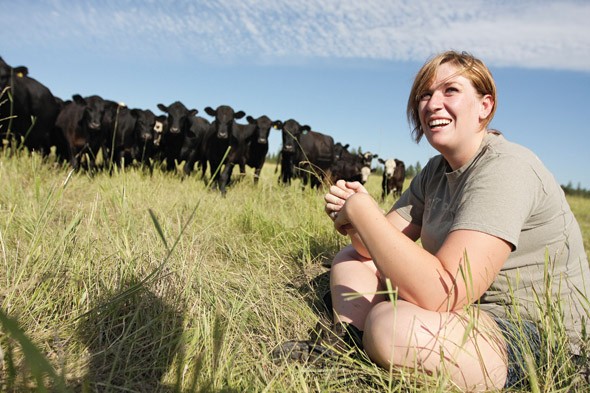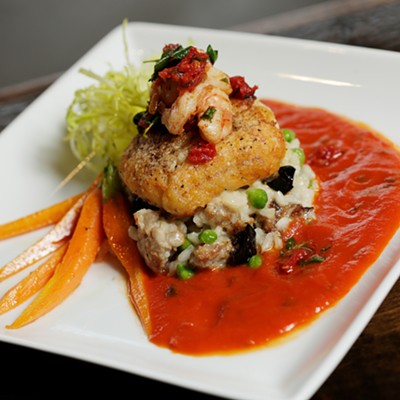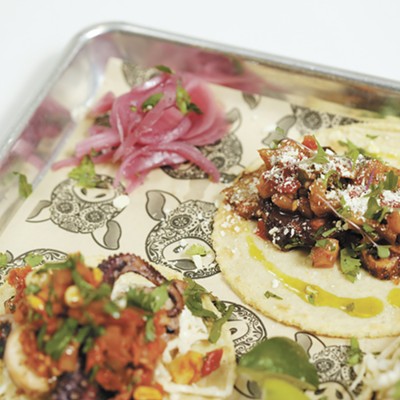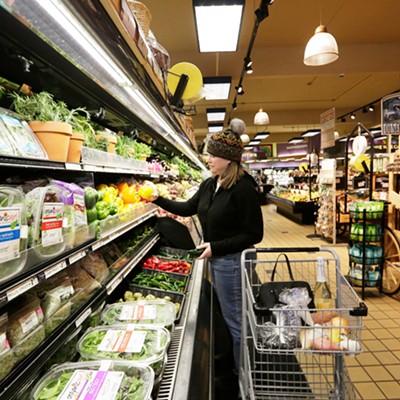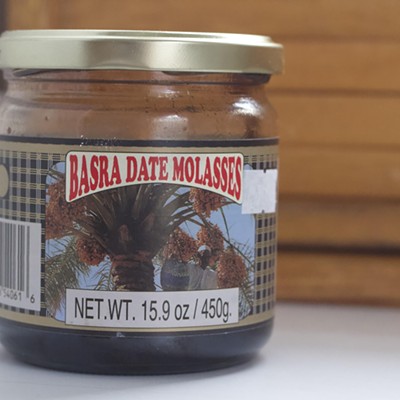She's running. Her sandals kick up a cloud of dirt, which floats over the field of chickpeas and swirls in the wind. The view is part pastoral, part urban wasteland. Rusted freezer boxes and a multicolored school bus lie abandoned, slowly being swallowed by weeds.
Mary Kate Wheeler is running after a marmot, and neither it nor the wind will get the best of her today.
“The marmots have the first third, the weeds have the second third and we’ve got all the rest,” she says of Ornery Heron Farm, a small organic farm she shares with her boyfriend in Latah Valley, about a mile from downtown Spokane.
Wheeler is protective of her chickpeas. She’s raised them from seeds that had been stored in Washington State University’s seed vault for more than 30 years, making them older than she is. Wheeler, 26, wears rolled-up Carhartt pants and a floppy cowboy hat over her blond hair. Dirt smears her upper lip. A farmer’s tan streaks her forearms and lower back from hours bent picking weeds.
This is her first attempt at farming.
The Vermont native moved to Spokane in October to work the land. She studied architecture and urban studies at Bowdoin College in Maine, but digging in the dirt is an entirely new experience. While studying abroad in Costa Rica, she met her boyfriend and learned about agriculture.
“We both started thinking a lot about agriculture and about the different social and environmental consequences in which people grow food,” she says. “I wanted to take this on as a learning experience and to see the sustainable techniques that I’ve learned about put into practice.”
Wheeler is part of a new wave of local farmers — young, inexperienced, at times naive — who’ve taken to small plots of land with large aspirations: to change how we grow our food.
Inspired by different things — a college course, a study-abroad program, a novel — these young people have turned to agriculture intentionally, setting them apart from previous generations of farmers who were either born or married into it.
They’re running small, sustainable farms and ranches that sell directly to consumers through farmers markets and restaurants, and they represent a tiny but impressive counterpoint to America’s enormous food industry.
In many ways, these new farmers are simply returning to old practices, working the land by hand and growing food for their neighbors.
•••
There’s no tractor or combine on Ornery Heron Farms. Wheeler and her partner, Brian Estes, 26, don’t even own a lawnmower.
“There’s still a lot of things we’re figuring out,” Wheeler says. “We’re trying to start this with really minimal inputs and be financially smart about it because we’re both very young and both very inexperienced.”
The couple lease a half-acre plot of vegetables, a half-acre of chickpeas and two acres of pasture from another local farmer, whose property is cobbled together among the greenhouses, weathered Craftsman homes and nurseries in Latah Valley.
Their entire farm is irrigated from a natural spring that intersects the property and is pumped into a gravity-fed water tank they bought on Craigslist for $100. Stacked on top of recycled wood pilings, the water tank is the highest point on the property. It irrigates the crops through an intricate system of drip lines and serves as the heart of this farm.
The couple got a late start to the planting season but plan to sell to farmers markets, restaurants and their own CSA (community-supported agriculture) box.
“We’re striving to create an alternative model of agriculture that works,” Wheeler says. “We’re trying to feed people in a healthy way that makes economic sense, spiritual sense, financial sense and environmental sense. But part of our experiment is finding out what it means financially to be farmers.”
Estes already has a taste for the profession. For the last three years, he’s been the program coordinator for the Vinegar Flats Community Garden. His gray-flecked hair hides beneath a sweat-soaked baseball cap, and his hands are stained from dirt.
The Tri-Cities native has a degree in psychology and a certificate in environmental studies from Gonzaga. His parents taught elementary school for more than 30 years, but his mother grew up on a large commercial farm in Wallla Walla.
“Growing
up, I always told my mother I wanted to be a teacher and she said, ‘Oh,
you don’t want to do that,’” Estes says. “The first time I was like,
‘Mom, I think I want to be a farmer,’ and she said, ‘Brian, I think you
would make a really good teacher.’
“That’s how I knew I hit the bottom of the barrel.”
Estes’ parents are now supportive of the idea. As a farmer, Estes approaches food as a social scientist, considering the relationships and consequences associated with each seedling he plants, each gallon of water he uses, each mouth he feeds.
“In school I was introduced to the idea that food is more than just calories,” he says. “The way we relate to our food can make a big difference in terms of how we relate to one another and how we relate to the world around us.”
The couple is aware of the obstacles they face — primarily, access to land and capital, but also perhaps their own naiveté. It is their youthfulness and lack of other responsibilities that makes this exactly the right time — and exactly the wrong time — to start a farm.
“I might be too stupid to know the risk I’m taking,” he says. “[But] if I can find a way to grow really delicious food and share it with other people, I’m going to stick with that.”
•••
Bryan Brown is a wanderer. The 24-year-old with curly brown hair and a beard strolls through a field, hands in his pocket. Before he learned to write grants, wrangle goats and collect seeds, he was a tennis instructor at a posh country club in his hometown of Bangor, Maine.
Today he’s an AmeriCorps volunteer at P.E.A.C.H. Community Farms, a nonprofit organization outside of Spokane that relies on volunteers to help grow produce for low-income families and for sale at farmers markets. He graduated from Colby College in Maine with a degree in biology. His parents are house appraisers.
“I never would have entertained the idea of becoming a farmer, but a sustainable agriculture class I took in college was really interesting,” he says.
After college, he volunteered through WWOOF — World Wide Opportunities on Organic Farms — and worked on farms in Chile and New Zealand for seven months. Now, eight farm internships later, he’s at P.E.A.C.H., hoping to go home to Maine and start a nonprofit farm of his own.
Brown smiles shyly as he explains that his parents don’t know of his plans yet, nor do they understand why he studied biology at an expensive private school. But today, on top of a rusty yellow bicycle, rolling along country roads past the goat barn and into the pasture, he’s not afraid of the future.
“There is definitely a movement growing among young populations who want to try and change the current system of agriculture and bring forth small-scale, locally based organics like here at P.E.A.C.H,” he says. “I love how it takes a community to grow this food.”
•••
"It's OK, mama. It’s OK, mama,” says Beth Robinette, 23, as she inches toward a calf that has just been born. The heifer snorts and thrashes her neck back and forth, protecting the brown baby that lies curled around her feet. The rest of the cattle come, as if beckoned. Robinette backs away.
The cows lazily drift across the pasture, which smells pungent and sweet. Turquoise skies span overhead as Robinette talks about holistic management, grazing techniques, and being chased by cows.
She climbs over barbed-wire fences. Her flip-flops and painted toenails stand out among the cow pies and thistles that dot the 800-acre pasture her family has owned since 1937.
Robinette is a fourth-generation cattle farmer at Lazy R Ranch in Cheney, Wash. She moved home after graduating from Western Washington University’s Fairhaven College in Bellingham, where she earned a self-designed degree entitled “Empowering Family Farms: Profiting from Sustainability.”
She says the “hippy-dippy, interdisciplinary school” and her progressive “philosopher cowboy father” helped shape her ideas about food.
“I always knew I wanted to do something with food, and of course I was raised with an awareness of food issues,” she says. “But then I read Fast Food Nation,” a book about the health and cultural consequences of America’s fast food industry.
“That really made me aware that there are so many problems in our food system,” she says. “People are so brutally taken advantage, not to mention the animals, and that just wasn’t right. I knew I had to do something about it.”
So she moved home, married her high school sweetheart, and reinvented her family’s farm. The ranch no longer sells its grass-fed, free-range beef into the commodity market or feed lots, “where they end up in McDonald’s hamburgers,” she says.
Instead, they sell 100 percent of their product directly to local consumers.
“I want to feed my community and feel like my community is invested in me,” she says. “I want to have people feel like they are part of the family, like they are a part of this business, and when they buy our beef, they are buying into an idea — not just pounds of beef in our freezer, but this philosophical belief that people can get behind.”
In the fall, she plans to attend Bainbridge Graduate Institute to receive an MBA in sustainable agriculture. She’s going back to school partly because she’s going stir-crazy back in her hometown, and partly because she hopes to make the farm more financially sustainable.
She thinks she’s an anomaly amongst generational farmers.
“The dogma is so persistent in the agricultural community, and a lot of young people either keep doing what their family has always done or they’re just leaving the farm altogether,” she says. “There’s an ever-increasing awareness that the food system is really broken and people don’t want to be a part of it anymore.”
But she’s not giving up.
“Every day is full of possibility,” she says and then laughs. “I know it’s totally cheesy, but I totally believe that. I feel so empowered to change the world for the better.”
•••
Hal Meenach, 59, is tired, and his back aches. Like Robinette, Meenach took over his family’s farm, and he’s proud of his profession. He’s in the middle of his 38th growing season in Spokane and Lincoln counties. He grows wheat and barley on more than 1,000 acres of land — parcels of his family’s homestead from 1904 — and exports it to international markets.
He says the risks of operating a farm are getting higher. Fertilizer alone costs him $700 per ton. A combine was $30,000 when he first got into the business, but now it’s closer to half a million dollars, and that combine burns through more than $100 worth of gasoline per hour. Because of equipment prices, labor costs, and insurance, he can’t afford to hire any help.
He’s aware of the new farmers like Wheeler and Brown and calls their small-scale operations “farmers market” farms.
“Lots of non-agriculture people have food ideas and people are interested in local food production,” he says. “ People are saying, ‘I don’t want all of my food to come from California,’ and it probably makes a lot of sense. And yeah, they might make a living, but it’s not going to be easy.”
Although Meenach is supportive of new blood and new ideas, he’s quick to add that farming is big business, it will get bigger, and these specialty farms barely make a dent in the national food system. Indeed, less than 1 percent of the country’s agricultural products are sold directly to the consumer, according to the 2007 Census of Agriculture.
“The cost and returns in agriculture simply isn’t enough,” Meenach says. “That’s why it has gotten so big. Now, you have no choice: You either get big or you starve to death.”
•••
Chad Kruger says he’s an optimistic person, but he thinks the national food system is rather grim. As director of WSU’s Center for Sustaining Agriculture & Natural Resources, he’s exposed to the entire gamut of farmers.
And as far as he’s concerned, no one has the right answer.
“Seventy to 80 percent of people in this country have no idea what the situation in agriculture is,” he says. “And without trying to paint too dark of a picture, I think there are some major challenges in front of us.”
Kruger cites the cost of energy, climate change, consumer convenience, the aging farmer population, global and economic dynamics, and what he describes as a “growers monopoly” in the United States.
He says small growers and the local food movement have seen a renaissance in the past 10 years, but by no means do they provide the answer or solution to the current agricultural system.
“The question is not, ‘How do small farms replace large-scale growers?’” he says. “I don’t think we’ll ever achieve that. The question is, ‘How do we make small farms more successful and more integrated into the national food system, and how do we make large commercial operations more sustainable?’”
The high-end products sold at farmers markets come with a heavier price and require intensive labor and more water. Part of their success, he says, is that operations are limited to small plots of land and niche, affluent markets. They couldn’t sustain themselves otherwise.
He’s troubled by the fact that farms are getting bigger and bigger nationally, but there still aren’t enough people doing small-scale farming — or even enough water — for it to supplant industrial agriculture. Kruger points to a study done by a WSU colleague, David Granatstein, which found that in order to feed everyone in King County from local sources, it would require one in four people to grow food.
“Are one in four people willing to grow?” he asks. “The answer is probably no.”
•••
Back on Ornery Heron Farms, Wheeler’s marmot chase is over. Both sides eventually won. The marmot got a mouthful of food, and Wheeler reclaimed her territory. At least for the afternoon. Her voice trails off into the wind as she traipses back through the field and questions whether or not their plants will grow.
“We planted so much of this stuff by seed,” she says. “How do you know if it’s going to come up?”
But there, in a little mount of dirt, a 30-year-old chickpea seed has become a little purple flower.
“Oh my God, they’re flowering,” she squeals. “Ahh, that’s so exciting!”
It’s a start.
“We’re hoping to be a model,” Wheeler says, “To show people what a small holistic farm can do, and to show that it’s possible to do it in Spokane.”


